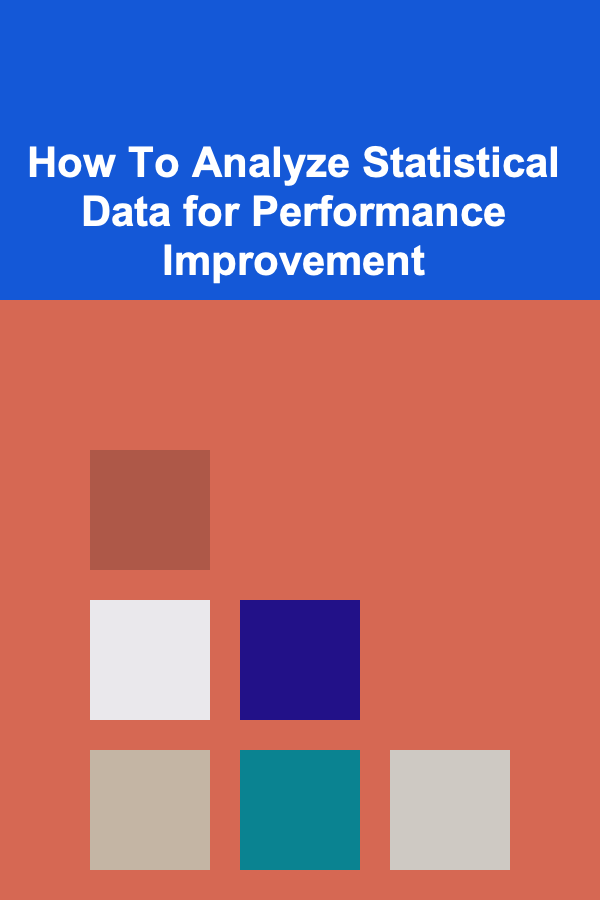
How To Analyze Statistical Data for Performance Improvement
ebook include PDF & Audio bundle (Micro Guide)
$12.99$7.99
Limited Time Offer! Order within the next:

Statistical data analysis plays a crucial role in performance improvement across various fields, including business, sports, healthcare, education, and manufacturing. By leveraging statistical tools and methodologies, organizations can extract meaningful insights from data, identify areas of improvement, and develop strategies to enhance performance. In this article, we will delve deep into how to effectively analyze statistical data for performance improvement, breaking down the steps, techniques, and tools used in the process.
Understanding Statistical Data Analysis
Statistical data analysis involves the process of collecting, organizing, interpreting, and presenting data to make informed decisions. In the context of performance improvement, the goal is to utilize statistical data to assess how well a system, team, or individual is performing and to identify opportunities for growth. The analysis can help in uncovering patterns, trends, correlations, and anomalies that might otherwise go unnoticed.
Performance improvement through statistical data analysis is not merely about understanding numbers; it's about turning raw data into actionable insights that drive informed decisions. The process requires a blend of critical thinking, domain knowledge, and expertise in statistical methods.
Steps to Analyze Statistical Data for Performance Improvement
1. Defining the Problem or Goal
The first step in analyzing statistical data for performance improvement is to clearly define the problem or goal. This step is essential because data analysis must be focused on specific objectives, whether it's improving sales performance, enhancing team productivity, optimizing healthcare outcomes, or increasing customer satisfaction.
To begin, ask the following questions:
- What aspect of performance needs improvement? (e.g., customer service, production efficiency, employee performance)
- What metrics or key performance indicators (KPIs) are relevant to this area?
- What outcomes do we hope to achieve from the improvement?
By answering these questions, you can establish a clear direction for your data analysis, ensuring that the subsequent steps are aligned with the performance improvement objectives.
2. Collecting Relevant Data
Once you've defined the performance goals, the next step is to collect relevant data. This is where the integrity and reliability of your analysis begin. The data collected should be both sufficient in quantity and relevant to the problem at hand.
There are two types of data you may need to consider:
- Quantitative Data: Numerical data that can be measured and analyzed statistically (e.g., sales numbers, test scores, production rates).
- Qualitative Data: Descriptive data that can be categorized and interpreted but is not always numerically measurable (e.g., customer feedback, employee satisfaction).
3. Data Cleaning and Preprocessing
Before diving into the analysis, data cleaning and preprocessing are essential. Raw data often contains errors, missing values, duplicates, or inconsistencies that can skew results. This step involves checking for outliers, correcting errors, and filling or removing missing data.
Common preprocessing tasks include:
- Removing duplicates: Eliminate any duplicate entries that could distort analysis.
- Handling missing data: Decide whether to fill missing values with averages, medians, or other imputation methods, or remove records with missing information.
- Transforming data: Standardize data formats, convert categorical variables into numerical values, or normalize values for comparison.
By cleaning the data, you ensure that the subsequent analysis is based on accurate, reliable information.
4. Choosing the Right Statistical Methods
With clean data in hand, the next step is to choose the appropriate statistical methods to analyze it. The method you choose depends on the type of data and the goals of your analysis. Common statistical techniques include:
Descriptive Statistics
Descriptive statistics help summarize and describe the features of a dataset. This includes:
- Mean: The average of the data points.
- Median: The middle value of the data when arranged in order.
- Mode: The value that appears most frequently.
- Standard deviation: A measure of how spread out the values in the dataset are.
These measures provide a quick overview of the data and can help you understand general trends or outliers.
Inferential Statistics
Inferential statistics are used to make predictions or inferences about a population based on a sample. Techniques like hypothesis testing, confidence intervals, and regression analysis fall into this category.
- Hypothesis Testing: Determines if there is enough statistical evidence to support or reject a hypothesis (e.g., testing if a new training program has improved employee productivity).
- Regression Analysis: Explores the relationship between variables (e.g., how customer satisfaction affects repeat purchases).
- ANOVA (Analysis of Variance): Compares the means of three or more groups to determine if they are significantly different.
Predictive Analytics
Predictive analytics uses statistical models and machine learning algorithms to predict future trends based on historical data. Techniques such as linear regression, decision trees, and neural networks are often employed to forecast future performance and guide decision-making.
Prescriptive Analytics
Prescriptive analytics goes a step beyond predictive analytics by recommending actions based on data analysis. For example, it may suggest strategies for improving customer service based on previous patterns of behavior or performance.
5. Analyzing the Data
After selecting the appropriate statistical techniques, you can begin the process of analyzing the data. This step involves applying the chosen methods to the dataset, calculating statistical measures, and interpreting the results.
For example, if you are analyzing sales performance:
- You might use descriptive statistics to determine average sales and identify trends over time.
- Inferential statistics could help you test if sales improvements are due to a specific campaign or external factors.
- Predictive analytics may forecast future sales based on past performance, helping to plan for demand.
The key at this stage is to not just compute statistics but also interpret the findings in a meaningful way. The insights derived from the analysis should be directly tied to the performance improvement goals.
6. Identifying Insights and Trends
Once you've completed the analysis, the next step is to identify actionable insights and trends. This involves looking for patterns, correlations, or anomalies that could provide guidance on how to improve performance.
For example:
- Positive Trends: If you notice that certain strategies or actions correlate with higher performance, these can be scaled or replicated.
- Negative Trends: Conversely, if you identify areas where performance has declined, you can investigate the causes and make adjustments.
- Outliers: Outliers can sometimes represent important insights, such as identifying exceptional performers or recognizing areas where interventions are necessary.
By identifying these patterns, you can start to formulate strategies for improving performance.
7. Making Data-Driven Decisions
The ultimate goal of analyzing statistical data for performance improvement is to make informed, data-driven decisions. This is where the findings from your analysis translate into actionable strategies. The decision-making process should focus on:
- Prioritizing areas for improvement: Identify the areas with the most potential for improvement and focus efforts on these.
- Developing action plans: Create clear, step-by-step plans based on the insights gained from the analysis. For instance, if the data shows that customer satisfaction is directly correlated with fast response times, improving response time could be a key focus.
- Setting performance benchmarks: Use the data to set realistic and measurable goals for future performance. These benchmarks can guide ongoing improvement efforts.
8. Monitoring and Re-Evaluating
Once you've implemented changes based on data analysis, it's important to continuously monitor progress and re-evaluate the effectiveness of your interventions. Regularly collecting new data and re-running statistical analyses can help you assess whether the changes are having the desired impact.
In many cases, performance improvement is an iterative process. By continuously analyzing data, adjusting strategies, and learning from past mistakes, organizations can foster long-term growth and improvement.
Tools and Techniques for Statistical Data Analysis
To streamline the process of statistical analysis, various tools and software can be used. Some of the most popular include:
1. Microsoft Excel
Excel is a versatile tool for basic statistical analysis, offering built-in functions for descriptive statistics, regression, and data visualization. It's widely accessible and user-friendly, making it a popular choice for initial data analysis.
2. R Programming
R is a powerful open-source programming language designed specifically for statistical analysis. It is widely used for more complex data analysis, including machine learning, data visualization, and statistical modeling.
3. Python
Python, with libraries such as Pandas, NumPy, and SciPy, is another powerful tool for data analysis. It's ideal for handling large datasets, running advanced statistical models, and automating analysis processes.
4. SPSS
SPSS (Statistical Package for the Social Sciences) is a software package used for statistical analysis in social science research. It is widely used in academic, healthcare, and business environments for its robust capabilities in survey data analysis and hypothesis testing.
5. Tableau
Tableau is a data visualization tool that helps present statistical data in interactive, visual formats. It allows users to create dashboards and share insights across teams, making it easier to communicate findings and track performance improvement over time.
Conclusion
Analyzing statistical data for performance improvement is a multifaceted process that requires careful planning, data collection, and the application of appropriate statistical methods. By defining clear goals, using the right tools and techniques, and interpreting results effectively, organizations can unlock valuable insights that drive performance enhancement. Whether in business, sports, healthcare, or any other field, leveraging data analysis to improve performance is a key factor in achieving sustained success and growth.

How to Choose the Right Technology for Remote Work
Read More
How to Create a Family Laundry Schedule
Read More
How to Grow Your YouTube Audience to Increase Your Earnings: An Actionable Guide
Read More
How to Use Corner Spaces Effectively with Specialized Furniture
Read More
How To Practice Timings and Cooldowns in Games
Read More
How to Build a Stronger Digestive System
Read MoreOther Products

How to Choose the Right Technology for Remote Work
Read More
How to Create a Family Laundry Schedule
Read More
How to Grow Your YouTube Audience to Increase Your Earnings: An Actionable Guide
Read More
How to Use Corner Spaces Effectively with Specialized Furniture
Read More
How To Practice Timings and Cooldowns in Games
Read More